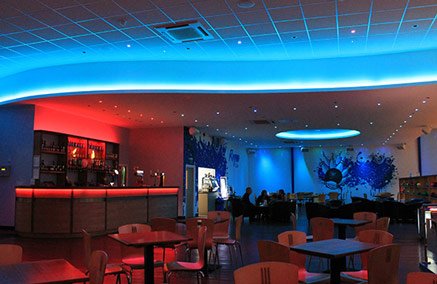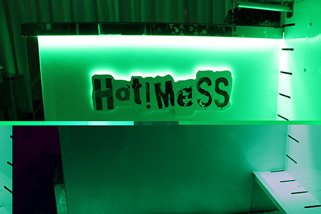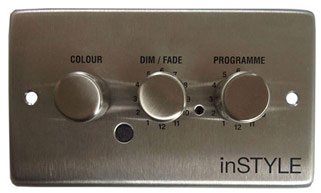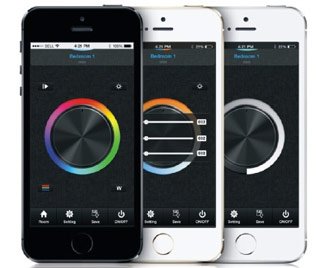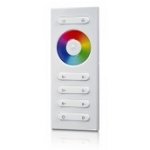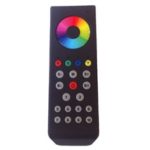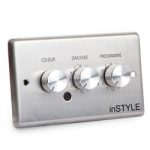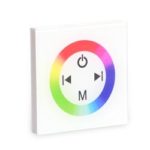Controllers For LEDs – control options for RGB/RGBW strip lights
Which RGB LED controller should I use? What’s the right choice for my project?
When it comes to controlling your RGB LED tape, there are a range of options – each offering a choice of many different controllers. If you decide to control your RGB LED tape via the DMX protocol, for example, you can use any DMX LED controller. This will give you a choice of hundreds of control units.
-
The size of your project
If you have a small project (using just a single transformer), this simplifies your choice of RGB LED controller options. You should avoid systems like DMX, 0-10v or DALI controllers – as these are primarily designed for bigger projects, with multiple zones or areas. Instead, you’ll want something you can use straight away – like an RF controller (these usually come with funky remotes) or an inline wired wall controller.
If you have a large project (30 LED strips, each with their own transformer, for example) then the opposite is true. You’ll need a control system than can manage multiple areas, such as DALI or DMX. These range from simple-to-use controllers, through more complex DMX control desks and laptop-based software – all the way up to DALI controller systems able to control large buildings.
-
The type of RGB LED controller you are looking for
If you’re looking for a fancy wireless touch-button LED controller, then you’ve already started to narrow down you choices by excluding wired controllers. There are many types of RGB LED controller to choose from – including wireless remotes, single and multichannel controllers, fancy glass touch controllers and more.
- For small projects – choose an RF LED controller or inline LED controller
- For large projects – choose from 0-10v / DMX / DALI controllers
What are the differences between all those types of RGB LED controller?
What is RF control for RGB LED tape?
When signalling to a paired receiver to control your LED tape, RF controllers have a range of up to 20 metres.
Single-zone RF controllers explained:
A single-zone LED controller allows you to control all of the LED tape that it’s connected to. But you can only control all of your strip lights together; you can’t set different areas to dim or display different colours independently.
For example a RGB DMX wall panel is a single-zone controller as it only has one set of colour / dimming / display-programme dials. But there’s no restriction on the amount of LED tape you can control from it, as one of this unit’s great features is the ability to pair multiple receivers to just one controller (meaning all of the connected LED tape will be controlled together). This lets you link multiple rooms or areas that can’t be wired together, and control them all from one LED controller.
Multizone RF controllers explained:
Multizone RF means the LED controller gives you the option to select multiple areas / zones / channels separately. You could manage under-cabinet lights on one zone and plinth lighting on another zone, for instance – both independently controlled via one multizone controller. You can even have multiple receivers on each zone.
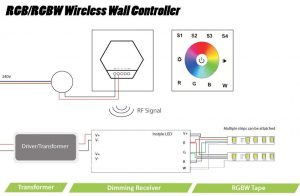
Or you could pair five receivers to your first channel and two receivers to your second channel, so that the receivers will dim their connected LED tape together whenever the controller adjusts the corresponding channel. This is very useful for setting different light levels within larger rooms, or in hotels, restaurants, shops and other businesses. InStyle LED offer several multizone RF controller options.
What are inline RGB LED controllers?
Inline RGB LED controllers are controllers that are wired in-between your transformer and your LED tape. They are typically used for very small installations, because they can’t be linked together to manage more LED tape than a single control-unit can control. InStyle offers one type of inline RGB controller – a glass-finish touch-control wall unit. This is a simple and cost-effective option with straightforward wiring, offering you basic colour scrolls and dimming.
What is DMX control for RGB LED Tape?
Simply enter the DMX channel you need (0 – 511), and the calculator will show you the corresponding DIP switch combination.
A decade ago you wouldn’t have heard of DMX control for the home, because the available controllers were all big, expensive and designed as control-desks for the theatre and entertainment industry. But things have changed. Now DMX controllers can be funky touch screen panels, wall controllers or apps for your smartphone or computer. DMX can be as simple or as complex as you wish, depending on your needs, and is ideal for homes to in your restaurants, clubs and hotels etc.
Installing a DMX system
With a DMX controller, your lighting choices are almost unlimited.
What is DALI control for RGB LED tape?

The main users of DALI controllers are hotels, offices or very large homes that really want the full works. Many DALI users also install smaller parallel controllers, so LED settings can be overridden within each room.
For wiring you should connect a DALI receiver in-between your transformer and LED tape (you’ll need our 3-channel DALI receiver – one channel each for red, green and blue). Then link all the DALI receivers together with signal cable and connect them to your DALI controller.
Can I control my RGB/RGBW LED tape from my iPhone / Android phone using an app?
The EasyLighting app is very easy to use. It will let you control multiple zones / areas, and select colour scrolls, full dimming and set multiple colours. You can even install hardware wall controllers or remotes as well, so you don’t have to use your phone all the time. These work through RF, so you’ll still have control if your WiFi should go down.
EasyLighting is available for Android and Apple devices – you can download here (Android) or here (Apple), and see our instructions for use here.
What is the difference between a zone and a channel?
In lighting terms, a zone and a channel are exactly the same. Both describe the ability to control one zone, channel or area independently. For example, a product that’s specified as a 2-channel LED controller can control two separate areas / zones.
What is the difference between single-channel and multichannel?
With a multichannel LED controller, you’ll be able to manage multiple channels (zones or areas) independently of each other – how many zones depends on the type of controller.
I have heard of control systems such as Lutron, HDL, Rako and Control 4. Can I use them with your RGB LED tape?
These products are advanced systems for the home. They can control many other systems in addition to your home lighting, such as closing blinds at certain times.
These control systems offer a wide choice of different models and controls, and also various ways to wire them up. Some use DALI controllers, 0-10v, TRIAC (mains dimming) or DMX. We have successfully installed our receivers with these systems, and we’ve tested them for compatibility and reliability.
If you’re looking for complete control of your home – with the option to set different lighting levels, pre-programme times, or switch off the whole house when you leave from the touch of a button, touchscreen or your IPad – then one of these systems is the way for you.
For projects in London and the surrounding area, our Lutron control-system specialist can offer practical advice on Lutron systems of all types, for commercial premises and large homes.
What RGB controllers do you offer?
InStyle’s range includes a variety of RGB LED touchpads, remotes and controllers. We offer the following (click on each picture for more information):
